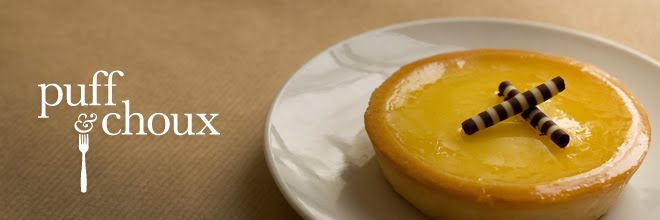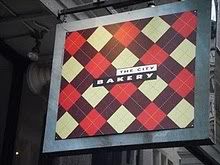
The fact that I have a lemon tartlette in my blog header should be a good indication that I enjoy lemon desserts. If lemon is part of the description when it comes to any tart, pie, bar, cupcake, or pudding, chances are I will eat it.
The main reason I love lemon desserts is that a lemon tart was what I would consider the first fancy-ish dessert I ever successfully made. Up until the lemon tart, I was pretty much sticking to basic recipes like fudge and brownies. However, the day I whipped up a lemon tart for the time, I felt accomplished, like I found something I was actually quite good at. Since that fateful day in my kitchen, lemons represent my love for baking and pastry. I guess the old saying of "when life hands you lemons, make lemonade" applies here. If I hadn't been laid off from my job, I never would have started this blog which eventually led me to the bounty that are lemon desserts.
There are two other reasons I love lemon desserts. The first reason is obviously taste. I find that with lemon dishes, especially bars and tarts, the pop of citrus flavor stays in your mouth all day. I find that to be the sign of a good dessert - if hours later, you can still taste the main flavor. I find nothing more satisfying than hours after eating a lemon bar, I can still taste it on the roof of my mouth. The only problem with this is that it leaves me wanting more. I've been known to eat entire lemon tarts in less than two days. But hey - I'm a dessert blogger. The way I see it, I'm supposed to eat loads of dessert as it's part of the job description.
The second reason I love lemony desserts is the aesthetic appeal. In my almost 28 years, I've never seen an ugly lemon dessert. The taste might be horrible and intestine twisting at times, but damn if lemon goodies don't present themselves well.
This year, I've become a devote user of the Baking Unplugged cookbook. I won't go into my usual speech of how it's probably one of the greatest baking cookbooks ever written as I typically do when the book comes up in this blog. But trust me - it's one of the greatest baking cookbooks ever written. So, after trying out the recipe for cream scones and having a successful result, I ventured further into the book. What did I find? Lemon squares. Delicious, yummy, easy-to-make lemon squares.
Prior to this baking endeavor, I had never made my own lemon squares, and my experience with this particular baked good has been a mixed bag. I've eaten some decent lemon squares at bakeries and coffee shops in my time. Last Christmas time, my sister received some Barefoot Contessa lemon square mix in her stocking, and although the results were kind of mushy (by no fault of my sister), the taste was pretty good. However, I feel that every lemon square I've eaten up until this point has lacked the zing of flavor I described earlier. The lemon squares of my past simply supplied me with enough lemon zestiness that could easily be found in most sub-par lemonade.
To my readers that have hung out with me in real life and not just on this blog, you know what one problem I have with baking is that after I try a recipe, I always say it's easy. Now I'm not a trained pastry chef, but I know I've pissed off quite a few people by referring to a recipe as easy, only to have a friend find themselves contemplating sticking their head in the oven instead of the prepared dough after spending an hour with a recipe I recommended. However, I promise you these lemon squares are simple. If you can mix ingredients together in a bowl, you can make these lemon bars.
As someone obsessed with her Scottish heritage (when I say "obsessed," I mean that i get really excited about the idea of visiting Edinburgh and I can tell the difference between Scottish, Irish, and English accents), I knew I was going to love the Baking Unplugged lemon bars when I saw the recipe called for a shortbread crust. The simple, buttery flavor of the crust provides a nice subtle background to showcase the lemon flavors. Plus, who can deny a crust with such a high butter content? It just tastes really good.

Also, as someone who loves the simplicity of a "pat in the pan" dough, the shortbread crust was ideal. After mixing the ingredients to form the dough, all one has to do is dump the dough into a 13 x 9 baking dish and mush the dough evenly along the bottom. If you have hands, you can mush. Easy peasy.
The lemon curd is second part of the recipe. After reading about my love affair with lemons earlier in this blog post, let me be clear on one thing: Although I love lemons and the desserts they produce, I absolutely loathe zesting any sort of fruit. Similar to my fear of tripping on subway stairs and knocking out my front teeth (something that has not happened to this day), I have an innate fear of accidentally zesting my hand or finger while tackling a lemon. Not only would the act of tearing flesh hurt, you get the added one-two punch of having acidic citrus juice in your wound. But, this recipe calls for zesting, so I zested. Unwillingly, mind you!
And is it just me, or is the word "curd" kind of gross? I don't know why I always envision some of grotesque nature when I hear "curd," but I'm willing to bet it's because it rhymes so easily with...well, you get the picture.

Anyway, back to the dessert. After baking, the lemon squares must sit for 1 to 2 hours. I hated this part of the recipe because after I pulled these bad boys out of the oven, I wanted to dig in. However, I witnessed the benefits of waiting. The puffiness of the baked curd subsided and I was left with beautifully yellow-hued lemon squares. Since I'm a lemon purist, I didn't bother with the suggested dusting of powdered sugar, but that's an option you might like to employ. Powdered sugar is also a great way to hide any blemishes on the squares' surface.
One last thing: Nicole Rees, author of Baking Unplugged, suggests using hazelnuts or almonds in the crust, I've eliminated them in the recipe below as I didn't use them in my final product.
Recipe for Lemon Squares (from Baking Unplugged by Nicole Rees)
Equipment:
13 x 9 Baking pan
Foil
Wooden spoon
Measuring cups
Measuring spoons
Whisk
Zester
Cooling rack
Juicer
Crust Ingredients:
14 Tbs. unsalted butter, melted and cooled to just warm
1/2 c. sugar
1/2 tsp. salt
2 C. all-purpose flour
Lemon Curd Ingredients:
4 large eggs
1 1/4 C. sugar
3 Tbs. all-purpose flour
1/8 tsp. salt
3/4 C. fresh lemon juice
1 Tbs. grated lemon zest
Powdered sugar (optional)
Preheat the oven to 325 degrees Fahrenheit. Line a 13 x 9 baking pan with foil, leaving an overhanging edge for easy removal. Lightly butter the sides of foil (not the bottom) to prevent the lemon curd from sticking. In a medium bowl, stir together the butter, sugar, and salt until just combined. Add the flour and stir until dough just come together. Press the mixture evenly into the pan. Prick the dough with a fork. Refrigerate for 30 minutes (or freeze for 5 to 7 minutes), until the dough is firm.
Bake for 25-minute, until the crust begins to set but has not bun to brown at the edges (the center will not be firm yet).
In a medium bowl, whisk together the eggs, sugar, flour, and salt until smooth, about 1 minute. Whisk in the lemon juice and zest. Pour the filling over the hot crust. Return the pan to oven and increase the heat to 350 degrees Fahrenheit. Bake for 20 minutes or until the center is set and the edges are golden. The topping will no longer wiggle when the pan is moved. Place the pan on a wire rack to cool for 1 to 2 hours. When the bottom of the pan is cool, carefully lift the bars from the pan using the foil overhang and transfer them to a cutting board. Cut into 2" squares. Dust with powdered sugar, if desired, before serving.
This recipe yields 2 dozen lemon squares.














